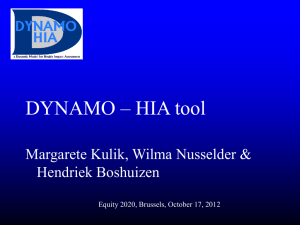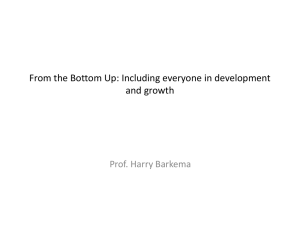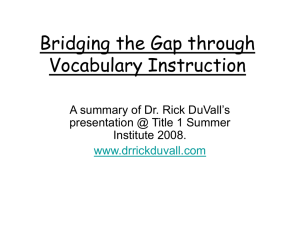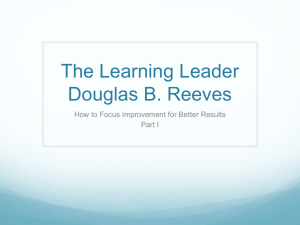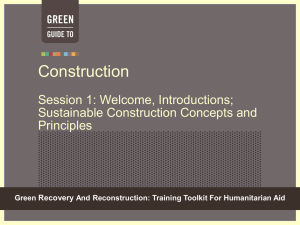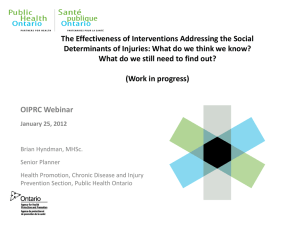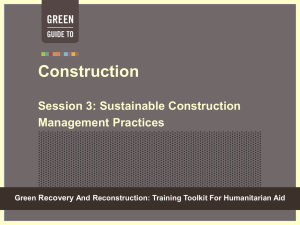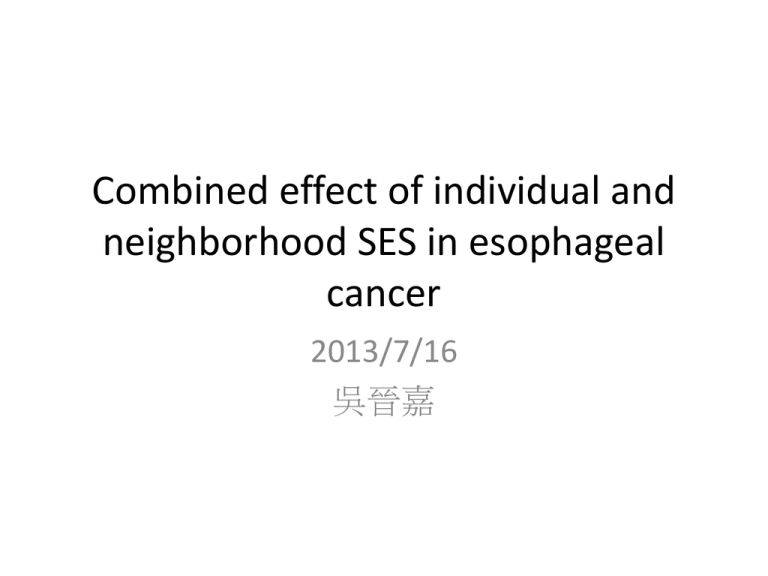
Combined effect of individual and
neighborhood SES in esophageal
cancer
2013/7/16
吳晉嘉
•
•
•
•
•
•
Topic
Literature Review
Coding sheet of literature
Introduction
Result
Limitation
• Combined effect of individual and
neighborhood SES in esophageal cancer
Literature Review
• Combined effect of individual and
neighborhood SES in gastric cancer patients
Literature.
• Pubmed: “socioeconomic status” AND
“esophageal cancer”
Coding Sheet
No
Journal
Year
Title
Authors
Main conclusion
1
NEJM
2003
Esophageal cancer
Enzinger
Review of esophageal cancer
2
BMC cancer 2012
incidence and survival of
esophageal and gastric
Coupland
cancer
incidence and
survival.Primary prevention
3
Indian
journal of
cancer
Risk factors and survival
analysis of the esophageal
Sehgal
cancer in the population
of Jammu, India
snuff, salt tea, smoking and
sundried food are the most
powerful risk factor of
esophageal cancer.
improve economic status
4
Asian Pacific
journal of
2011
cancer
prevention
Epidemiologic risk factors
fir esiohageal cacer
Mao
development
Rsik factors and EC
development
Nitrosamine, tabacco abd
alcohol, BE and GERDm
nutrition, HPV
BJC
2006
Role of SES in decision
making on dx and tx of
esophageal cancer in
Netherlands
individual SES related to
histology . Higher SES related
to resection. Lower SES:
stent. High SES: more C/T but
not significant
2004
Trends and SES inequality
Coleman
in cancer survival
5
6
BJC
2012
Vliet
Deprived patients not
benefitial from earlier
diagnosis and treatment
Ref: Dixon, High SES more
resources
SES , staging and treat
decisions in EC
7
JCGE
8
international
journal of
2009
epidemiolog
y
SES, population based case
control study in high risk Islami
area,Iran
high SES, low risk.
9
Journal of
epidemiol
2001
Coomunity
health
Neighborhood SES and
health outcomes
Pickett
Neighborhood SES rekated to
health outcom
10
Cancer
epidemiolog 2005
y
SES and esophageal
adenocarcinoma in
Sweden
Jansson
individual SES related EAC and
ESC, high ==> low. Especially
without partner.
11
health and
quality of life 2009
outcomes
Quality of life as
prognostic factor in cancer Montazeri
survival.
Fatigue, physical function
PLOS one
Sociodemographic and
geographical factor in EC
and GC mortality in
Sweden
neighborhood : density high
==> poorer outcome. Single:
poorer. High education: better
outcome
12
2012
2013
BUS
Curative treatment==> similar
SES related to tx
survival. Neighborhood. High
choice.Netherlan. Related to
==> curative resection, or
patient and physician??
CCRT ==> better survival
Ljung
Individual. Multiple SES
measures. Occupation, area,
education
high SES, low risk.
Disadvantaged group ==>
lower survival but not
significant
Canada remove SES inequality
more than US
13
EJC
2008
Sociol inequality, incidence
and survival of EC and GC Baastrup
and PC in Denmark
14
JCO
1999
Community income and
cancer survival
2006
Impact if SES ib death rate
after surgery for UGI
Leigh
cancer
After surgery, social
deprivation significant
associated mortality
Boyd
15
BJC
16
CA: cancer J
2011
clin
Global cancer statistics
Jemal
Statistics
17
international
journal of
2007
epidemiolog
y
SES, risk of GC and EC in
European
Nagel
GC related to SES, others no
specific.
Ann Surg
Oncol.
Outcome of Patients with
Esophageal Cancer: A
Chen
Nationwide Analysis.
18
2013
age, sex, and curative
treatment were significant
predictors of lifetime survival
in patients with esophageal
cancer.
• SES related to esophageal cancer incidence.
• In developed country EAC and ESCC related to
high SES ( Denmark )
• In developing countries ESCC related to low
SES
• SES related to treatment choice of esophageal
cancer
• Surgery improved outcome
• Low Neighborhood SES related higher postesophagectomy mortality.
• Plos one 2013 : neighborhood and individual
SES, but no combination.
• Limited literature about combined effect of
neighborhood and individual SES
Study Design
• Taiwan’s NHIRD for the years 2002 to 2006.
• 6557 Esophageal cancer patient
• Combined Individual SES and neighborhood
SES survival
• Individual: occupation and insurance income
• Neighborhood: average household income
台灣不分性別 每10萬人口標準化發生率
(2000年世界標準人口),2002-2006年
食道
個案數
平均年齡
年齡中位數
標準化率
癌症百分比
2002
1,310
61
61
5.47
2.08%
2003
1,356
61
61
5.42
2.14%
2004
1,534
60
59
5.99
2.16%
2005
1,527
59
58
5.76
2.13%
2006
1,764
59
57
6.44
2.34%
年度
7,491
國健局網站 癌登系統
<65 years old
食道
年度
個案數
平均年齡
年齡中位數
標準化率
癌症百分比
2002
787
52
52
3.65
2.34%
2003
810
52
52
3.61
2.41%
2004
963
52
52
4.17
2.56%
2005
983
51
51
4.07
2.58%
2006
1,175
52
52
4.74
2.95
>65years old
食道
年度
個案數
平均年齡
年齡中位數
標準化率
癌症百分比
2002
523
74
73
25.78
1.77%
2003
546
74
74
25.69
1.84%
2004
571
74
73
26.4
1.72%
2005
544
74
73
24.61
1.62%
2006
589
75
74
25.47
1.66%
Limitation
• No staging ( If limited to curative resection,
may overcome this bias ) previous review
showed that the most important factor is
“curative resection”
• No histopathological report ( more than 90%
in Asian is SCC )

